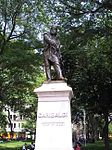Washington Square Arch
Buildings and structures completed in 1892Fifth AvenueGeorge Washington in artGreenwich VillageLatin inscriptions ... and 9 more
Monuments and memorials in ManhattanMonuments and memorials to George Washington in the United StatesNew York (state) historical anniversariesSculptures carved by the Piccirilli BrothersTerminating vistas in the United StatesTourist attractions in ManhattanTriumphal arches in the United StatesUse mdy dates from March 2020Vandalized works of art in New York City

The Washington Square Arch, officially the Washington Arch, is a marble memorial arch in Washington Square Park, in the Greenwich Village neighborhood of Lower Manhattan, New York City. Designed by architect Stanford White in 1891, it commemorates the centennial of George Washington's 1789 inauguration as President of the United States, and forms the southern terminus of Fifth Avenue.
Excerpt from the Wikipedia article Washington Square Arch (License: CC BY-SA 3.0, Authors, Images).Washington Square Arch
Washington Square North, New York Manhattan
Geographical coordinates (GPS) Address Nearby Places Show on map
Geographical coordinates (GPS)
| Latitude | Longitude |
|---|---|
| N 40.7312355 ° | E -73.9971028 ° |
Address
New York University
Washington Square North
10012 New York, Manhattan
New York, United States
Open on Google Maps







